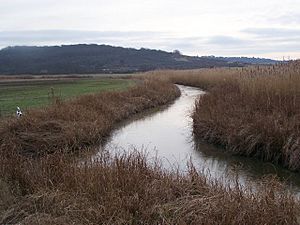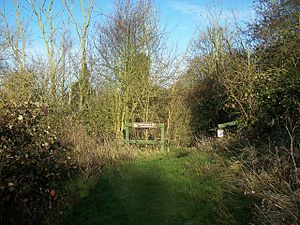High Halstow NNR facts for kids
| Site of Special Scientific Interest | |
 |
|
| Area of Search | Kent |
|---|---|
| Grid reference | TQ781763 |
| Interest | Biological, ornithological |
| Area | 129.7 acres (52.5 ha) |
| Notification | 1951 |
The High Halstow National Nature Reserve is a special place for nature found on the Hoo Peninsula in Kent, north of Chatham. It's also part of a bigger area called the Northwood Hill RSPB Reserve. This whole area covers about 270 hectares, which includes grassy marshes, woodlands, and farmlands. High Halstow was made a National Nature Reserve way back in 1951, meaning it's protected to help wildlife thrive.
The reserve and its woodlands sit on a hill just north of the village of High Halstow. It's a fantastic spot to explore and learn about different plants and animals.
Contents
Welcome to High Halstow Nature Reserve!
This amazing nature reserve is a protected area where many different kinds of plants and animals live. It's a great example of how we can help nature stay healthy and safe for everyone to enjoy.
What You Can See Here
The woodlands at High Halstow are built on a type of soil called London Clay. This soil helps many different plants grow.
Amazing Plants and Trees
You'll find lots of big oak trees here. There are also many hawthorn bushes, which have pretty white flowers in spring and red berries in autumn. You might also spot some sycamore trees. In the past, there were many English elm trees, but sadly, most of them were lost because of a sickness called Dutch elm disease.
Even with the loss of the elms, the woodland is full of life! Over 200 different kinds of plants, including trees and shrubs, have been found here. It's like a giant outdoor classroom for plant lovers.
Incredible Animals and Insects
High Halstow is famous for its many different kinds of butterflies. It's also home to some rare moths. For example, you might see the sloe carpet moth (Aleucis distinctata) or the least carpet moth (Idaea vulpinaria). A special group of white-letter hairstreak butterflies also lives here. These butterflies are quite rare, so it's exciting to see them!
If you look near the water, you might spot some of the nine different kinds of dragonfly species that have been recorded in the reserve. They are beautiful and fast flyers!
The reserve is also a special home for birds. You can hear the beautiful song of nightingales here. And since the year 2000, High Halstow has become home to the UK's largest and most famous groups of little egrets. These elegant white birds have been nesting here, and by 2007, there were about 93 pairs! It's an amazing sight to see so many of them.
Visiting the Reserve
You can visit the reserve in a couple of ways. One way is to park your car at the carpark off Northwood Avenue, which is to the south of the woodland. Another option is to go to Buckland Farm, which is the RSPCA Farm and carpark, located to the west of the woodland.
Once you're there, you can follow a nature trail. This trail offers lovely views of the sea and long-distance views of the River Medway. It's a great place for a walk and to enjoy nature.
The Saxon Shore Way, a long walking path, also goes through the reserve. It connects the villages of Cooling and High Halstow.
A Smuggler's Secret Spot
Did you know that this wooded hill was once used by smugglers? Back in the early 1700s, these secret traders would hide their goods here.
One story from 1728 tells of some men from Medway. In February 1726, they crossed the English Channel in a small ship called The Sloweley. They were bringing in over 400 pounds (180 kg) of tea from Ostend, a city in Belgium. They also had some calico fabric and silk handkerchiefs.
Once they landed on the Kent shore, they quickly hid all these smuggled items in the woodland on Northward Hill. Later, they moved the goods to Chalk church, likely to keep them hidden even better. It's a fascinating piece of history for this quiet nature reserve!


